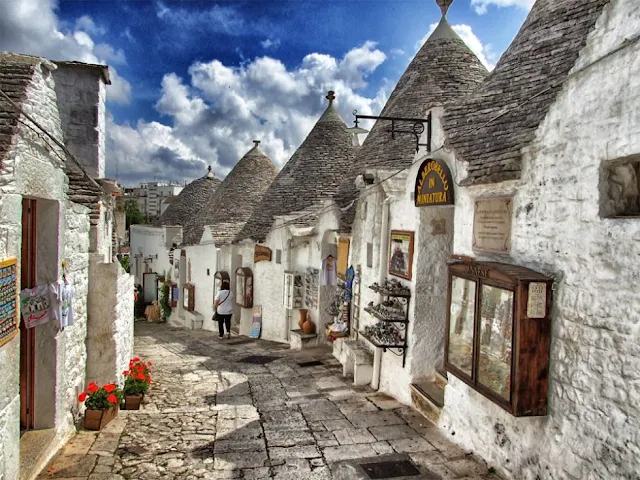The Rock Islands of Palau, also called Chelbacheb, are a collection of several hundred small limestone or coral uprises in the Southern Lagoon of Palau between Koror and Peleliu, now an incorporated part of Koror State. There are between 250 and 300 islands in the group according to different sources, with an aggregate area of 42 square kilometres (16 sq mi) and a maximum height of 207 meters (679 ft). The islands were declared a UNESCO World Heritage Site in 2012
The Rock Islands are sparsely populated and famous for their beaches, blue lagoons, and the peculiar umbrella-like shapes of many of the islands themselves. Many of the islands display a mushroom-like shape with a narrower base at the intertidal notch. The indentation comes from erosion and from the dense community of sponges, bivalves, chitons, snails, urchins, and others that graze mostly on algae.
Rock Islands Southern Lagoon covers includes 445 uninhabited limestone islands of volcanic origin. Many of them display unique mushroom-like shapes in turquoise lagoons surrounded by coral reefs. The aesthetic beauty of the site is heightened by a complex reef system featuring over 385 coral species and different types of habitat. They sustain a large diversity of plants, birds and marine life including dugong and at least thirteen shark species. The site harbours the highest concentration of marine lakes anywhere, isolated bodies of seawater separated from the ocean by land barriers. They are among the islands’ distinctive features and sustain high endemism of populations which continue to yield new species discoveries. The remains of stonework villages, as well as burial sites and rock art, bear testimony to the organization of small island communities over some three millennia. The abandonment of the villages in the 17th and 18th centuries illustrates the consequences of climate change, population growth and subsistence behaviour on a society living in a marginal marine environment.
A 4,912 ha site encompassing the Rock Islands has been designated an Important Bird Area (IBA) by BirdLife International because it supports populations of most of Palau’s endemic birds, including Micronesian megapodes, Palau ground doves, Micronesian imperial pigeons, Palau fruit doves, swiftlets and kingfishers, Micronesian myzomelas, morningbirds, Palau fantails, flycatchers and bush warblers, giant, dusky and citrine white-eyes, and Micronesian starlings.
The islands and surrounding reefs include Palau's most popular tourist sites, such as the Blue Corner, Blue Holes, German Channel, Ngermeaus Island, and the famed Jellyfish Lake, one of many marine lakes in the Rock Islands that provides home and safety for several kinds of stingless jellyfish found only in Palau. It is the most popular diving destination in Palau, offering some of the most diverse dive sites on the planet, from wall diving and high current drift dives, to manta rays and sharkfeeds, to shallow lagoons, decorated caves, and overhangs. Tourist attractions also include Dolphin Bay, where a staff of veterinarians and trainers educate guests about dolphins.
The only inhabited place on the islands is called Dolphin Bay (on Ngeruktabel, 5 km from Koror). It is the location of Palau's national aquatics park, and hosts headquarters of Palau's Park rangers.
The marine site covers 100,200 ha and is characterized by coral reefs and a diversity of other marine habitats, as well as 445 coralline limestone islands uplifted due to volcanism and shaped over time by weather, wind and vegetation. This has created an extremely high habitat complexity, including the highest concentration of marine lakes in the world, which continue to yield new species discoveries. The terrestrial environment is lush and at the same time harsh, supporting numerous endemic and endangered species. Although presently uninhabited, the islands were once home to Palauan settlements, and Palauans continue to use the area and its resources for cultural and recreational purposes. This is regulated through a traditional governance system that remains an important part of national identity.
The islands contain a significant set of cultural remains relating to an occupation over some five thousand years that ended in abandonment. Archaeological remains and rock art sites are found in two island clusters - Ulong and Negmelis, and on three islands - Ngeruktabel, Ngeanges, and Chomedokl. Remains of former human occupation in caves, including rock art and burials, testifies to seasonal human occupation and use of the marine ecosystem, dating back to 3,100 BP and extending over some 2,500 years.
Permanent stone villages on a few islands, some dating back to between 950 and 500 BP, were occupied for several centuries before being abandoned in the 17th-18th centuries, when the population moved to larger islands. The villages include the remains of defensive walls, terraces and house platforms. The settlements reflect distinctive responses to their local environment and their abandonment demonstrates the consequences of population growth and climate change impacting on subsistence in a marginal environment.
The descendants of the people who moved from the Rock Islands to the main islands of Palau identify with their ancestral islands through oral traditions that record in legends, myths, dances, and proverbs, and traditional place names the land- and seascape of their former homes.




















































